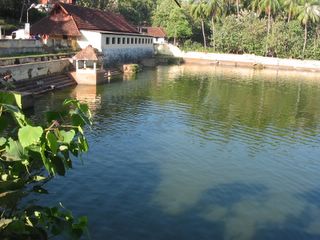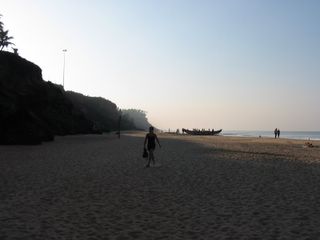
View of the morning sea with lone tourist performing yoga
In addition to being touristy, Varkala is also popular religious place for many locals and perhaps for many Keralites as well. Two centres that attract pilgrims are Janardhana Swamy temple and Sivagiri Mutt. Janardhana Swamy temple is on the way to the Papanasam beach, a pleasant sandy beach sandwiched between two cliffs. If one turns right just before the temple, the road winds past the Taj hotel to the north cliff. The road to the left leads to the South Cliff. Although there are some places to stay on the south cliff, it is the north cliff that attracts all attention.

Tank2

North cliff from the beach
A long winding path along the edge of the north cliff has all the ingredients that make a tourist haven: knick-knack shops selling ware from lands as far as Rajasthan, Kashmir and Tibet; restaurants with displays of fresh fish on ice that dole out non-fish dishes as well and an occasional shack that serves only veg food; places to stay with varying degrees of comfort.

on a fish hunt...

Cliff frontage at night
The main tourist zone is sandwiched between the path along the cliff and the road that leads to the north cliff from the Janardhana Swamy temple. While most tourist eat in the shacks on the cliffs watching the sea below, many stay in hotels, resorts and homes behind the cliff frontage.
It heart-warming to see small houses (some of the inhabitants still cooking on wood-stoves in the backyard) have managed to transform a room or two into a space that can be rented out to tourists. Tourism industry has given them an opportunity to earn some money. The little lanes that dot this cliff are all clean without any rubbish. Tourists can be seen enjoying the sunshine filtered through palm fronds while sitting on little tables with checked table cloth in many back yards (with the days wash still on the lines). Kerala seem to be encouraging such home-stays, which is good both for the tourist as well as the host. I would any day suggest tourists to stay at such places than at sterile resorts that the rich prefer or rodent infested cheap hotels that the back packers prefer.
Our task, the few days that we spend in Varkala before the group arrived, was to find out places to visit and restaurants to eat in. It was when the group was here I realise why hotel folk kow-tow to tour operators: the group follows what the leader says to the last dot! While Janardhana Swamy temple was a definite place to visit, we though Sivagiri mutt, though a very nice place, would not have interested these tourists. So we went on an auto ride to Anjengo, an old English Fort about 20 km away to see if it would be of interest.
Anjengo (or five coconut trees) was for a while the second most important trading port for the English after Bombay in the late 17th century. This fort is said to have been built in 1695. Actually before I found this information on the net, RJ told me that this was a Dutch port. Somewhere else it was also written that Portuguese were also here. So instead of trying to waste time arguing who owned it first and how it changed hands, we decided to visit it. We also found out that a place called the ‘Golden Island’ just off the road to Anjengo that may be of interest as well.
The route to the fort was extremely picturesque with the sea on the right and coconut trees everywhere. The way the swaying coconut trees framed the sea and the waves, it was almost a different picture frame ever few meter. Another interesting feature along the route was the number of mosques. This 20 km strip had over 10 mosques with few very large as well. I am not sure if the local population can fill even one of these large mosques completely. Doesn’t say much about the camaraderie these fishermen villages share with one and another.

Fishermen pusing the boat into the sea
Anjengo, perhaps due to the European influence has some missionary school and few churches. The village by itself was nothing spectacular. We realised that the main gate of the fort was locked with worker repairing the wall inside. The guard has just gone out for a cup of tea, we were told. A light-house that was close-by could have kept our occupied until the guard’s return but the visitors were welcomed only in the early evening. As we turned to walk back to the fort, we saw someone waving frantically: it was the guard.
The fort in itself was just the walls. The main structure has collapsed many years ago. The ASI is now trying to repair the walls (with nice cement plaster as well) so that this skeleton remains. The walls are so thick that one can easily walk over them and perhaps it was meant so as there were steps everywhere that lead to the top of the walls. Neither the fort in itself nor the views of the sea/village from the fort walls was interesting enough for the group to be here. So we went to see the Golden Island.
This island was not easily accessible. One would have to take some narrow paths that finally lead to the backwaters. The island was just a hop away on a dug-out canoe. The place was straight out of a picture post card from the tropics: it was filled with coconut trees that brought resplendent emerald green hue to the entire landscape. Right on the banks was a coir unit with women beating out the coir from the shells that have been soaked for 3 months.
Years ago, I worked with a group of women in a small village near Visakhapatnam to set up a small coir yarn making unit. Although they received good training thanks to a motivated trainer from the government, we could compete neither in quality nor in price against the golden yellow 2-ply coir yarn that came from Kerala. After seeing unit here making coir and another unit making yarn a little later, I have realised how could we have even thought of setting up a coir unit in Vizag of all places? While I was pacifying myself that history was full of such faux pas, RJ was taking snaps of people coming back from the Island after visiting the two temples there. There is nothing else on the island other than these two temples, which we forgot to mention to the group. They learnt the hard way (some of them wanted to have lunch there) that glorious sounding names mean nothing.
Some more pictures

3 comments:
you blog is soo cool ..
i really like it ;)
Hi Imp,
So far so good. Just my 2 cents, I think to pep up ur posts a bit further, U can slowly start to introduce us to some of the colorful members of Ur firangee tour party. Maybe u have already planned that in Ur upcoming posts.. but if u have not, then plz consider my suggestion. A bit of human angle (some conversation tit-bits exchanged between the group members & you) would spice up Ur post just nice. What do U say ??
The best of the series so far. This is a very good travel writing, however to nitpick, there were too many grammatical errors. Maybe you didn't do even a routine pass over the text once?
The best of travel writing makes you want to be at the places, crave for those experiences. And this one surely does!
off to read more,
asuph
Post a Comment